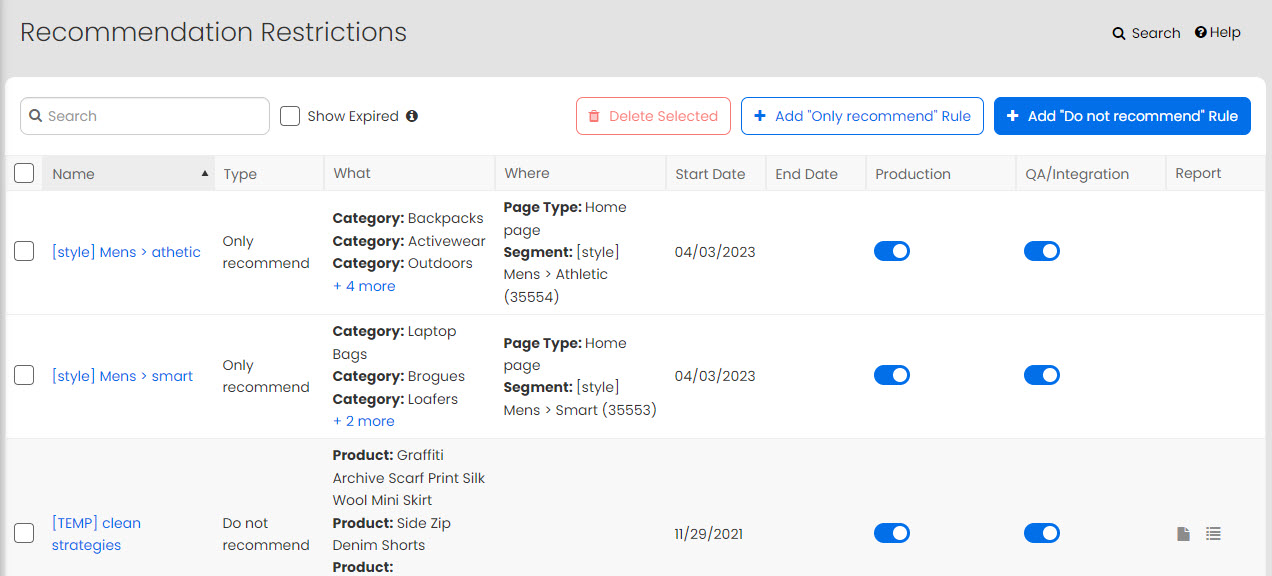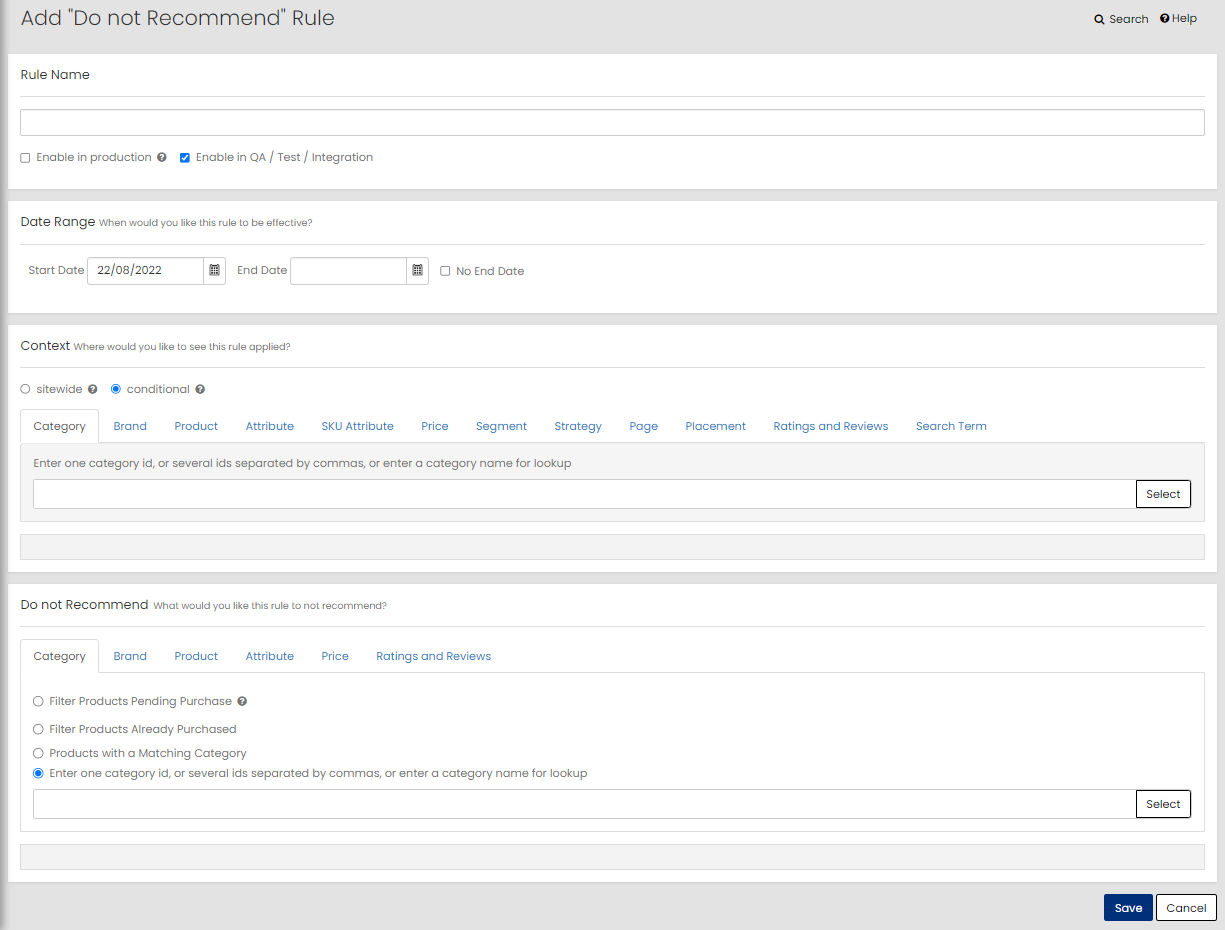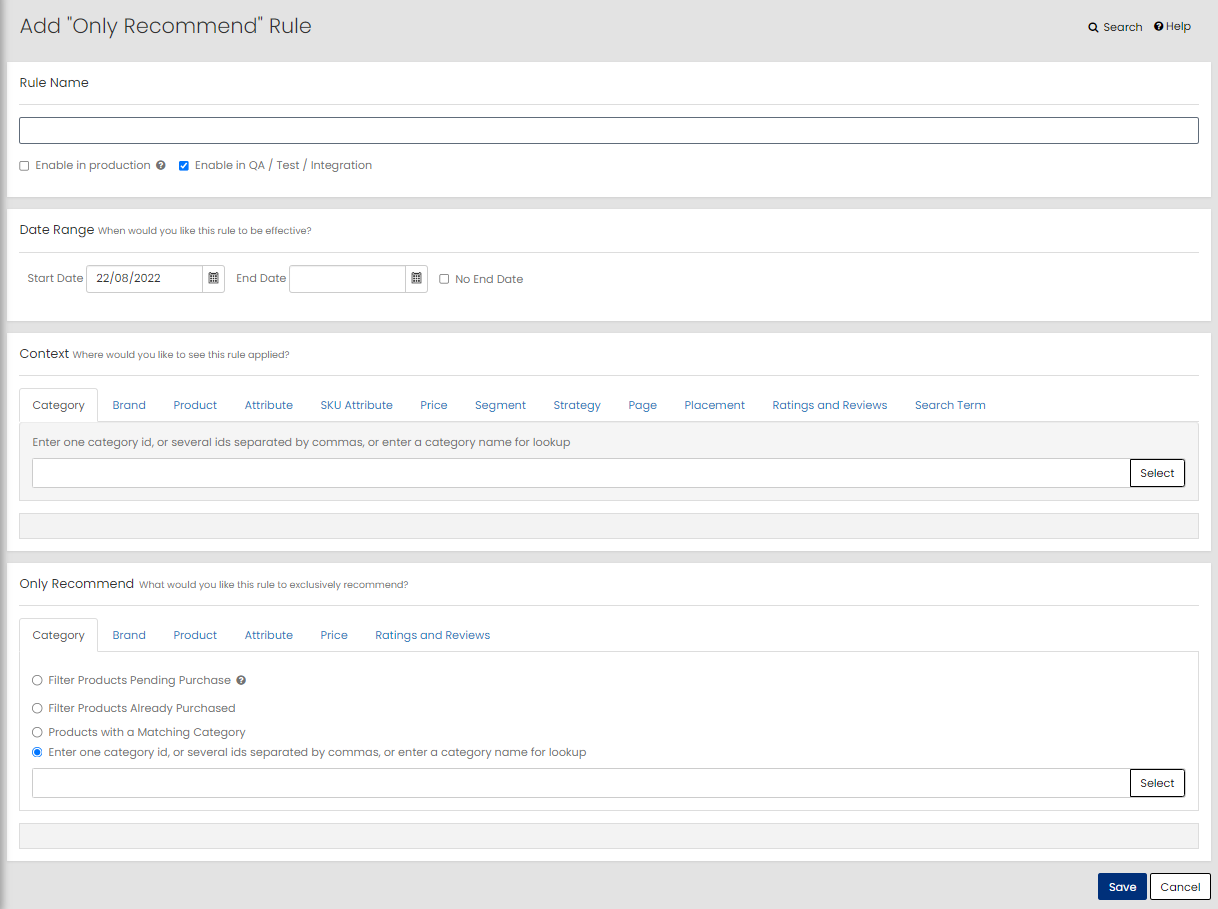Create New Recommendation Restriction Rules
This section includes step-by-step instructions for creating Recommendation Restriction rules in Recommend.
To create a new rule for recommendation restriction:
- On the Omnichannel Personalization Dashboard page, go to Recommendations > Recommendation Restrictions.

- Click Add "Do not recommend" Rule or Add "Only recommend" Rule.
- Specify a name for your rule. This is a simple description of business objective that the "Only recommend" or "Do not recommend" rule is trying to meet. This is never shown to the customer.
- Select the Enable in production checkbox to enable the rule to be in production environment as soon as it is created or select the Enable in QA/Test/Integration checkbox to test it first in the QA/Test/Integration environment, and then enable it later for production environment.
-
Specify the start date from when the rule becomes active. The rule becomes active midnight on the date specified, per the time zone configured for your site.
-
Specify the end date or select the No End Date checkbox to let the rule run indefinitely. The end date is inclusive. For example, if you set the end date to be March 31, 2022, the rule will be active until March 31, 2022, 23:59:59.
-
In the Context area, specify where you want to apply the rule:
-
For Only recommend rule: The context of the rule is applied only for the specific areas of your site and not for the entire site. To specify the context for the rule, go to the step #8.
-
For Do not recommend rule: The context of the rule can be applied either for the specific areas of your site or for the entire site.
-
Select sitewide, if you want the rule to be applied across the entire site. The Context area disappears for the sitewide context, hence skip the step #8.
-
Select conditional, if you want the rule to be applied conditionally in specific areas of your site. To specify the conditional context for the rule, go to the step #8.
-
-
-
Specify one or more conditions where the "Only recommend" or "Do not recommend"(for conditional context) rule will be active.
You can use the following condition types:
-
Category: The category of the current page (applicable to item, add_to_cart, cart, purchase, and category pages).
-
Brand: The brand of the product.
-
Product: A specific product (applicable to item, add_to_cart, purchase, and cart pages).
-
Attribute: Target products that have specific attributes (applicable to item, add_to_cart, purchase, and cart pages).
-
SKU Attribute: Specify the SKU attribute name and its value.
-
Price: Target products that have a certain price range (applicable to item, add_to_cart, purchase, and cart pages).
Note: If the page belongs to more than one category, the rule applies if any of the page's categories match the rule. For example, if your rule targets the Electronics category, it will be applicable to a page that belongs to both the Toys and the Electronics categories.
Note: If currency is defined in the product region feed or XML feed, merchants will be able to specify currency specific rules for price.
-
Segment: Customers that belong to a market segment specified by the retailer
-
Strategy: Select strategies that the rule should apply to.
-
Page: The page type where you want the "Only recommend" or "Do not recommend" rule to occur. For example, you can not recommend a specific category of products on the home page.
-
Placement: The placement where you want the "Only recommend" or "Do not recommend" rule to occur.
-
Ratings and Reviews: Ratings and reviews of the product.
-
Search Term: Specify the search terms you want this rule to apply to.
-
-
Specify the products for ''Only recommend'' or ''Do not recommend'' rule by specifying a list of products or describing the products by their attributes.
You can use the following attributes:
- Category: The category of the product. If a product belongs to more than one category, it qualifies for the rule if any of its categories match. For example, if you have a rule that says do not recommend Toys, a product that belongs to Electronics and Toys will not be recommended. Select any one of the following from the Category tab:
Filter Products Pending Purchase: The category where the products in pending for purchase are selected to apply either the "Only recommend" or "Do not recommend" rule.
Filter Products Already Purchased: The category where the products already purchased are selected to apply either the "Only recommend" or "Do not recommend" rule.
Products with a Matching Category: The products with a matching category are selected to apply either the "Only recommend" or "Do not recommend" rule.
Enter one category id, or several ids separated by commas, or enter a category name for lookup: Specify the category ID to apply either the "Only recommend" or "Do not recommend" rule.
- Brand: The brand of the product. Select any one of the following from the Brand tab.
-
Products with a Matching Brand: The products with a matching brand are selected to apply either the "Only recommend" or "Do not recommend" rule.
-
Enter the brand names you want this rule to apply to: Specify the brand name to apply either "Only recommend" or "Do not recommend" rule.
- Product: A specific product (applicable to item, add_to_cart, purchase, and cart pages). Specify the following from the Product tab:
-
Enter one product id, or several ids, separated by commas, or enter a product name for lookup: Specify the product IDs to apply either the "Only recommend" or "Do not recommend" rule.
-
New products that have been added recently:
-
New products added to the catalog in the last X days: Specify the number of days to boost new products. This is to ensure that the shoppers see a good mix of new products in their recommendations.
-
- Attribute: Target products that have specific attributes (applicable to item, add_to_cart, purchase, and cart pages). You can target products using those attributes you shared with us in the catalog feed. Select any one of the following from the Attribute tab:
-
Products with a matching attribute: Specify the matching attribute of the product to apply either the "Only recommend" or "Do not recommend" rule.
-
Products do not match the attribute value: Specify the attribute value which does not match with the product to apply either the "Only recommend" or "Do not recommend" rule.
The product is defined with the attribute name and value which are used to apply the rule for a specific context to the category to have the same value for that attribute.
For example,
-
If a customer is looking for AA size batteries, the recommendation should not be shown for the same AA size batteries, and instead recommend the other battery sizes.
-
If a customer is looking for a pen with some brand, recommend the same brand but a different color.
-
-
Products with a matching attribute name and value (name and value are case sensitive and must exactly match the feed data): Specify the matching attribute name and attribute value to apply either the "Only recommend" or "Do not recommend" rule.
-
Products with a matching attribute name but not value (name and value are case sensitive and must exactly match the feed data): Specify the matching attribute name and not matching the attribute value to apply either the "Only recommend" or "Do not recommend" rule.
-
Apply diversity filter by attribute: Diversify recommendations by any product attribute so that user can use recommendations for product discovery, Specify the attribute name and the number of products between 1 and 10 to apply to the "Only recommend" rule.
- Price: Use the minimum sale price if it's specified, else use the list price. Specify the following from the Price tab:
-
Specify a Price Range: Specify the minimum and maximum price range.
-
Specify a price comparison: Specify the price comparison.
Note: If currency is defined in the product region feed or XML feed, merchants will be able to specify currency specific rules for price.
-
Ratings and Reviews: Ratings and reviews of the product. Specify the following from the Ratings and Reviews tab:
-
Product Ratings: Specify the product ratings between 1 and 5.
-
Product Reviews: Specify the number of product reviews between 1 and 1000.
-
User: Recommend or do not recommend products with the same attribute value as products the user has previously viewed or purchased.
- Products with attributes that match a user's attribute: Specify the attribute name.
- Products with attributes that match a user's attribute: Specify the attribute name.
- Filter products the user has already viewed: Specify the number of days between 0 to 365.
- Filter products with a matching attribute value as products the user has already viewed: Specify the attribute and the number of days. If this option is enabled products with the same attribute value as products in the user's view history will be filtered out from recommendations.
- Filter products with a matching attribute value as products the user has already purchased: Add the attribute and specify the number of days. If this option is enabled products with the same attribute value as products in the user's purchase history will be filtered out from recommendations.
For Only recommend rule:
For Do not recommend rule:
- Category: The category of the product. If a product belongs to more than one category, it qualifies for the rule if any of its categories match. For example, if you have a rule that says do not recommend Toys, a product that belongs to Electronics and Toys will not be recommended. Select any one of the following from the Category tab:
-
Click Save.
The rule will be active on the site within 30 minutes. The start date is managed by the system, so the rule will not be visible to customers until that date.
The ''Do not recommend'' rule allows you to specify what products to not recommend to a customer.

The ''Only recommend'' rule allows you to specify what products the customer should only see. This rule prevents any other products other than the ones specified in the rule to be shown.

Note: If you are unsure of the time zone configured for your site, contact the Algonomy support team..